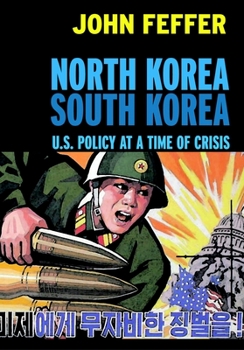North Korea South Korea: U.S. Policy at a Time of Crisis
Select Format
Select Condition 
Book Overview
The Korean peninsula, divided for more than fifty years, is stuck in a time warp. Millions of troops face one another along the Demilitarized Zone separating communist North Korea and capitalist South Korea. In the early 1990s and again in 2002-2003, the United States and its allies have gone to the brink of war with North Korea. Misinterpretations and misunderstandings are fueling the crisis. "There is no country of comparable significance concerning...
Format:Paperback
Language:English
ISBN:1583226036
ISBN13:9781583226032
Release Date:September 2003
Publisher:Seven Stories Press
Length:200 Pages
Weight:0.40 lbs.
Dimensions:0.4" x 5.1" x 7.1"
Customer Reviews
5 ratings
Outstanding; clear and concise discussion
Published by Thriftbooks.com User , 20 years ago
After WWII, Feffer writes, the Americans installed Syngman Rhee in the South and the Russians installed Kim Il Sung in the North. The Rhee regime had little popular support. In 1948 on the island of Cheju, in suppressing a rebellion, the regime killed about 60,000. Overall the U.S. backed regime killed about 100,000 oppositionists in its first five years.. South Korea started many border clashes with the North beginning in the Summer of 1949 causing huge casualties Kim Il Sung, in the famous early 1950 meeting that gets anti-communist ideologues all excited, was granted permission to invade the South after he convinced Stalin that he would get the operation over with quickly and thus hopefully discourage the Americans from intervening militarily. The Americans were eventually able to push the North Koreans back. . Macarthur's deliberately provocative march northward up the peninsula towards the Yalu river, Korea's border with China, brought the Chinese army into the conflict. The Americans engaged in extensive bombing and napalming of civilians. They wiped off the map about three quarters of North Korea. In June 1953, they started bombing dams and water reservoirs in North Korea, which effects included the mass flooding of rice and other agricultural fields. Thus by inducing starvation the Americans induced the North to agree to a truce. Some Nazis got hanged for implementing such a policy during WWII. The North Koreans committed their share of atrocities. U.S. planners were embarrassed as the North's economy regularly outstripped the South's into the mid-70's. General Park Chung Hee seized power in the South in 1961. He set up a state planning economic regime. It was based on tight state discipline of labor and consumption austerity with workers treated pretty badly. Unrest spread and in 1980, the military under the new dictator General Chun perpetrated a bloody massacre in the city of Kwangju. A revitalized labor movement eventually forced democratic change on the U.S. backed military. By the late 80's South Korea was one of the top economies in the world; in 1960 it had been at the level of Sub-Saharan Africa. Its principles violated all the prescriptions of the free market-as did the rest of the Asian tigers and has the U.S. with its military-industrial complex fueling its hi tech economy. . In any case, South Korea was pressured to remove controls on capital flows and this led to the Asian financial crises of the late 90's. Western companies swarmed in to buy up the fire sale of bankrupt indigenous companies. This incident of course, makes North Korea pause about extending its free market reforms) as does the extreme poverty and social chaos existing in China's Free Market revolution. In the 70's North Korea borrowed from foreign creditors and fell heavily into debt. Agricultural plots for private sale were allowed in the 80's. The latter led to clearing of land and deforestation, which contributed mightily to the floods contribut
Great Book on North/South Korea-US Relations
Published by Thriftbooks.com User , 20 years ago
I enjoyed this book very much. It covers a wide variety of issues concerning U.S.-North Korea-South Korea relations. North Korea is a country we as Americans know so little about. This is a great introductory book to the U.S. policies towards North Korea and why even the U.S. Government's ally, South Korea doesn't agree with their policies. A definite must-read for anyone interested in International Affairs.
This is the perfect primer
Published by Thriftbooks.com User , 20 years ago
In one sitting, this book offers the inquiring reader a complete lesson on all that one needs to know about one of the most dangerous spots on the globe. It is well written, concise, and to the point. What lesson it offers are worth knowning, especially if one is worried about the Bush administration pre-emptive strike policy.
Excellent treatment of current crisis
Published by Thriftbooks.com User , 21 years ago
I want to recommend this book, "North Korea, South Korea. It is a through, comprehensive, well balanced , non-inflamatory treatment of the history and current situation that will greatly enlighten any reader desiring to get to the truth about this mysterious country.
FINALLY, A FAIR AND HONEST ANALYSIS
Published by Thriftbooks.com User , 21 years ago
John Feffer's new book on US policy towards Korea is refreshing, honest and a critical contribution, particularly in these strange political times when foreign policy is being made in the dark. This book is a MUST READ for anyone who wants to understand US policy towards Korea, especially those working towards a peaceful resolution. Feffer clearly understands the importance of viewing U.S.-North Korea relations in a historical context and does a brilliant job outlining the key events. To top, Feffer is a talented writer with a fluid style that keeps the reader turning the pages.





